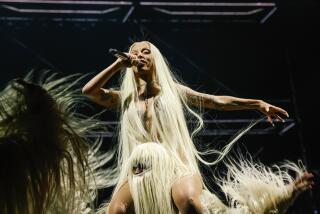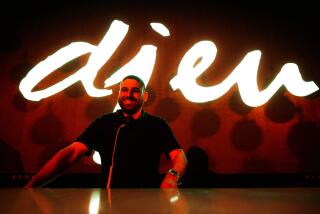Stars’ Rhythms Help Get Reggae Out of Its Trance
- Share via
Even reggae music has room to grow. The genre’s true artists know it isn’t enough to sing piously of God and freedom across a simple trance rhythm. As Steel Pulse demonstrated again Saturday at the Teva Spirit of Unity festival at Irvine Meadows Amphitheatre, the most meaningful reggae is made by those willing to push the form a little further.
More than two decades after forming amid the British punk scene in Birmingham, England, Steel Pulse continues to offer layers of sound without losing momentum. Its sophisticated rock-reggae mix is precise and often moving, and the band even attempted a pop-reggae mix when Selwyn Brown stepped out from behind his keyboards to rap on “Taxi Driver.”
As with Saturday’s other participants, Steel Pulse’s best moments came by demonstrating that the basic reggae trance rhythm could become a canvas of endless possibility, rather than an avenue of monotony.
That dynamic vision unfortunately was not shared by soulful reggae crooner Beres Hammond, who seemed content with his rumbling beat and flat songwriting.
By contrast, Jamaican-born Shaggy walked onstage with some energetic hip-hop attitude, mixing crisp raggamuffin rapping and pop melodies accessible enough for the Top-40 crowd. A clean-cut front man in a bright yellow shirt, Shaggy and his band offered the least traditional set of the day while calling on the surprisingly small crowd to clap and sing along.
“Be advised,” Shaggy told his audience, “when you come to a reggae party you don’t sit in your chairs like it’s an opera.”
Not surprisingly, his performance had more to do with showmanship than musical experimentation. Shaggy’s set was light, but pleasant enough with his heavy R&B; lover-man vibe--he sang lots of songs “for the ladies”--and at one point he even dropped in the key riff from the Supremes’ “Where Did Our Love Go?”
Shaggy’s band also tried pop-ragga versions of Harry Belafonte’s “Banana Boat (Day-O)” and Janis Joplin’s “Piece of My Heart.” He found a smooth comfort zone with both, but never reached the emotional heights of the originals.
For connoisseurs of African pop, the appearance of South African artist Lucky Dube was the main event of the day. Though largely unknown in the U.S., his big-band reggae sound was uplifting and dynamic, blending ragga essentials with an Afro-pop flavor, inspiring much of the crowd to its feet.
Dube was given to broad, dramatic gestures, carrying himself like the star he is in Africa. Not content with his 10-member band’s deep reggae groove, the singer led the group through rich instrumental flourishes and tightly choreographed dance steps. He tossed in surprising pieces of western pop music, from Bob Dylan’s “Knockin’ on Heaven’s Door” to Deep Purple’s “Smoke on the Water,” but was equally effective with messages on peace and unity.
“If politicians had taught us as much about freedom as they had about apartheid,” Dube told the crowd, “then South Africa wouldn’t be what it is today.”
An early high point came from Nasio Fontaine, a young and charismatic reggae traditionalist whose pumping thumping riddims offered occasional bursts of electric guitar and squealing organ.
Fontaine carried a walking stick for dramatic effect, but often stopped his pacing across the stage to slap at the hand drums, repeating the day’s mantra: “We must get together! What you say?”
He was a warm but energetic presence, singing odes to Jah and warnings against nuclear weapons, as two background singers added an occasional gospel lilt to the music.
More to Read
The biggest entertainment stories
Get our big stories about Hollywood, film, television, music, arts, culture and more right in your inbox as soon as they publish.
You may occasionally receive promotional content from the Los Angeles Times.











